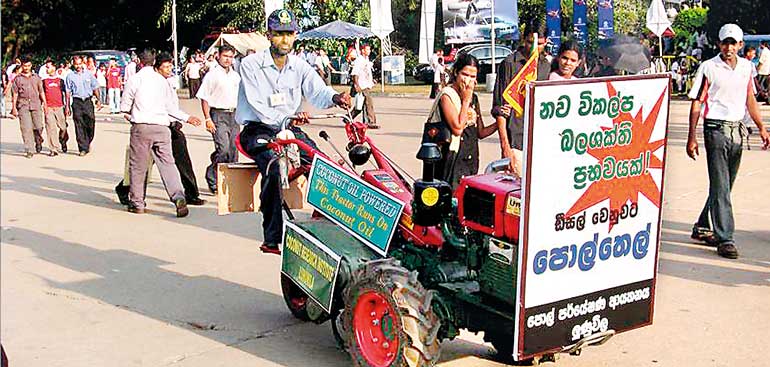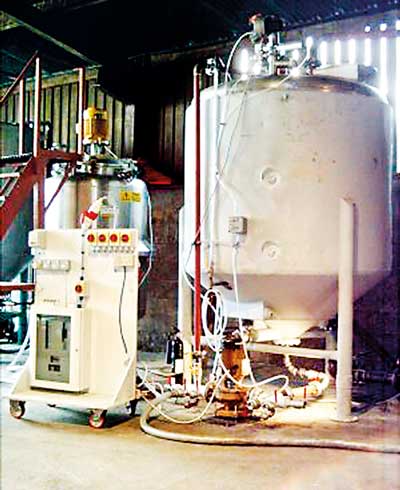Friday Dec 13, 2024
Friday Dec 13, 2024
Thursday, 17 September 2015 00:00 - - {{hitsCtrl.values.hits}}

Biodiesel-powered tractor in Sri Lanka

Introduction
Energy Symposium 2015 was the eye opener and change agent of thinking in terms of energy conservation and alternative energy options.
Dr. Abdul Kalam was the guest speaker and he delivered the facts of important topic with stunning information. Among them diminishing of fossil fuels, renewable energy, preservation of village concept (Sri Lanka blessed with 40,000 villages) and the externalities, captured the thinking of the educated audience.
He unveiled many alternative energies pertaining to the context of Sri Lanka i.e. wind, hydrogen, thorium, solar and biodiesel were a few of them. Among these he elaborated much on biodiesel which on par with the Sri Lankan village wealth and the remarkable efficiency of the source rather than traditional diesel and less pollutants like sulphur and particles.

Biodiesel is not a new concept to Sri Lankan researchers. The Coconut Research Institute experimented on the subject and demonstrated by driving a hand-tractor on biodiesel in the year 2007. A research paper was presented at the Kotelawala Defence University International Symposium in 2008 about the commercial advantages of biodiesel in Sri Lankan concept.
The astonishing fact here is neither the Government nor the commercial sector made any attempt to develop and reap the benefits of the source. My attempt here is to publish the summary of the paper that I have produced in the Kotelawala Defence University International Symposium for the public to understand the value and the relevance of the source to the country.
Biodiesel is a very common concept all over the world though Sri Lanka is at a primitive stage as far as the knowledge and application of the biodiesel concept is concerned. Alternative energy is the only scapegoat to the present energy crisis. Therefore, it is important to study the fruitfulness of biodiesel and apply it to society and the country.
Sri Lanka is blessed with adequate raw materials that can be used as the biodiesel. They are kaneru, domba, mee, rubber seeds, etc. Also, people have the knowledge of the industry of these raw materials with indigenous experience. Biodiesel has three times more efficiency of fossil fuel diesel when considering the chemical and economic factors. Therefore, it can have a better impact on the financial sector of the country. The most important factor is the domestic manufacturing of biodiesel and this kind of micro economic industries which gives highest productivity to the country.
Already the biodiesel system has been tested in the country and this had been developed by the Coconut Research Institute and they have demonstrated driving a vehicle using converted coconut oil biodiesel. The main problem in Sri Lanka is the innovations are not integrated with the commercial sector, therefore the product innovations are dying inside laboratories or take much time to reach the market. Therefore, the biodiesel concept needs more integration with the commercial sector, Government and society in order to improve the economic state of the country.

Historical background
Trans-esterification of a vegetable oil was conducted as early as 1853 by scientists E. Duffy and J. Patrick many years before the first diesel combustion engine became functional. Rudolf Diesel’s prime model, a single 10 ft (3m) iron cylinder with a flywheel at its base, ran on its own power for the first time in Germany on 10 August 1893. In remembrance of this event, 10 August has been declared ‘International Biodiesel Day’.
Research into the use of trans-esterified sunflower oil, and refining it to diesel fuel standards, was initiated in South Africa in 1979. By 1983 the process for producing fuel-quality, engine-tested biodiesel was completed and published internationally. An Austrian company erected the first biodiesel pilot plant in November 1987, and the first industrial-scale plant in April 1989.
Throughout the 1990s, plants were opened in many European countries, including the Czech Republic, Germany and Sweden. France launched local production of biodiesel fuel (referred to as diester), which is mixed into regular diesel fuel at a level of 5%, and into the diesel fuel used by public transportation at a level of 30%. Renault, Peugeot and other manufacturers have certified truck engines for use with up to that level of partial biodiesel; experiments with 50% biodiesel are underway.
In 1998 the Austrian Bio Fuels Institute had identified 21 countries with commercial biodiesel projects. In September 2005 Minnesota became the first US state to mandate that all diesel fuel sold in the State contains part biodiesel, requiring a content of at least 2% biodiesel.
Production and scientific explanation of biodiesel
Chemically, trans-esterified biodiesel comprises a mix of mono-alkyl esters of long chain fatty acids. The most common form uses methanol to produce methyl esters as it is the cheapest alcohol available, though ethanol can be used to produce an ethyl ester biodiesel and higher alcohols such as isopropanol and butanol have also been used.
Using alcohols of higher molecular weights improves the cold flow properties of the resulting ester, at the cost of a less efficient trans-esterification reaction. After this processing, unlike straight vegetable oil, bio has combustion properties very similar to those of petroleum diesel, and can replace it in most current uses. Biodiesel is more efficient than fossil fuel diesel; the cetane value is three times higher than fossil diesel.
Biodiesel feedstock
Seeds are used as a source of biodiesel. Apart from that, a variety of oils can be used to produce biodiesel. These include:
Waste vegetable oil (WVO);
Animal fats including tallow, lard, yellow grease, chicken fat, and the by-products of the production of omega-3 fatty acids from fish oil.
 New Zealand has successfully developed a system for using sewage waste as a substrate for algae and then producing biodiesel.
New Zealand has successfully developed a system for using sewage waste as a substrate for algae and then producing biodiesel.
Thermal depolymerisation is an important new process that reduces almost any hydrocarbon based feedstock, including non-oil-based feed stocks into light crude oil.
Biodiesel feedstock plants utilise photosynthesis to convert solar energy into chemical energy. The stored chemical energy is released when it is burned, therefore plants can offer a sustainable oil source for biodiesel production. Most of the carbon dioxide emitted when burning biodiesel is simply recycling that which was absorbed during plant growth, so the net production of greenhouse gases is small. The highest yield feedstock for biodiesel is algae, which can produce 250 times the amount of oil per acre as soybeans.
The following seeds are abundance in Sri Lanka: endaru, kitul, palmyra, mango, tamarind, avocado, kaneru, jack seeds, rambutan, mee, margosa, domba and rubber. Biodiesel can be extracted basically from any seed that has a kernel. But there are high fat seeds like domba and mee of which Sri Lankan people possess knowledge.
Efficiency of biodiesel and economic arguments
A farm land consumes 82ltr/Hect (8.75Gal/Acre) to produce a crop.
An average crop produce oil 1029-1356 ltr/Hect (110 – 145 gal/Acre).
Ratio of input to output is 1:12.5-16.5.
Basic energy yield ratio of biodiesel to fossil diesel is 1:3.2 (Considering overall effects).
A gallon of biodiesel produces 2.25 gal of ethanol.
Biodiesel is becoming of interest to companies interested in commercial scale production as well as more usual home brew biodiesel user and the user of straight vegetable oil or waste vegetable oil in diesel engines. Homemade biodiesel processors are many and varied. The success of biodiesel home brewing, and micro-economy-of-scale operations, continue to shatter the conventional business myth that large economy-of-scale operations are the most efficient and profitable. It is becoming increasingly apparent that small-scale, localised, low-impact energy keeps more resources and revenue within communities, reduces damage to the environment, and requires less waste management.
 Conclusion
Conclusion
The most important factor in Sri Lanka is people have the knowhow of the system, which scientists have tested and demonstrated. Therefore, the requirement of making the conversion device is the most important factor. This equipment is available in the world market in various capacities from micro industries to macro industries with better economy of scale.
At the moment, the most productive industry in the country is micro level industry or self-employment industry. Therefore, it can be started with a micro level and subsequently developed to macro level with the investor who is in the fuel industry. However, considering the present economic status of the country, the micro economic industries are the best because, it eliminates the middle men process and gives highest productivity and service to the customer and society as far as rural areas are concerned.
The person who possesses the conversion mechanism can supply the seeds for the production and market the product to the customer in the same village since rural areas are based on an agricultural economy. There will be a great market from tractor owners and hand tractor owners and other people who need the products. When it comes to macro level it needs better integration of backward process and the customer with the blessings of the Government in order to achieve a better productivity.
In 2005, the US imposed a law in Minnesota State to add 2% biodiesel to the fossil fuel consumption; likewise with the present state of seeds available in the country, Sri Lanka too can reduce about 20% fossil fuel imports and secure a greater income to the country.
The biodiesel concept is one of the areas which should be known by the people in the country. The Ministry of Energy should launch awareness programs to educate people of the country about biodiesel energy. The country also can observe that there are various institutes which conduct researches on alternative energy but nothing gets commercialised due to less integration with the Government sector and the commercial sector of the country. Therefore, eradication of that negative status will give better results too for the implementation of biodiesel concept in Sri Lanka.
Ethically, it is not recommended to source edible food to produce biodiesel, but as I have elaborated there are plenty of inedible seeds in abundance in the country. Finally, as Dr. Abdul Kalam stated, Sri Lanka can achieve energy security and the energy independence through the biodiesel concept.
(The author, MSc, Chartered Transporter, is a specialist in transportation geography. He presently conducts lectures for the Transportation and Logistics Management Degree at CINEC Maritime University. He had published many articles on transportation and management and can be contacted via [email protected].)